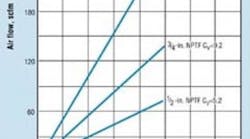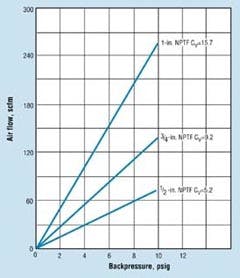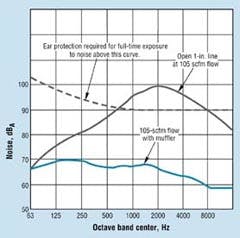But regulations go one step further by spelling out noise and emissions limits allowed for specific durations. For example, exhaust noise from a pneumatic system as high as 115 dBA is acceptable. However, workers may only be exposed to this noise for 15 min within an 8-hr shift. So if workers will be near the exhaust of a pneumatic system for an entire 8-hr shift, noise to only 90 dBA is allowed.
As far as emissions go, compressed air exhaust may not exceed 4.32 ppm of oil mist contamination in any 8-hr work shift of a 40-hr work week. Manufacturers state that this level can be achieved easily with a coalescing muffler, which typically reduces emissions to 0.015 ppm. Without coalescing mufflers, contamination as high as 50 ppm or more may exist in a plant that is tightly closed for operation in cold weather. Internal geometry to reduce air velocity and baffles for audio damping take care of noise; filtration takes care of the oil. But just any filter-muffler may not suffice.
A coalescing muffler operates on the same principles as a coalescing filter. As air flows through the coalescing element, oil particles are captured by three different mechanisms: direct interception, inertial impaction, and diffusion. In direct interception, oil particles simply collide with and are trapped by filter fibers. With inertial impaction, the element's turbulent air stream throws oil particles against fibers, which trap the oil. Diffusion causes the smallest particles to vibrate and collide with each other — and eventually the element's fibers - which traps the oil.
Whatever the choice, mufflers that remove oil from the exhaust air should be considered - especially if air exhausts near workers. It is not uncommon for coalescing mufflers to remove 99.97% of the entrained oil. Even if oil-free compressors are used, exhaust mufflers can reduce noise to OSHA-acceptable levels and ensure that exhausted air is clean.



